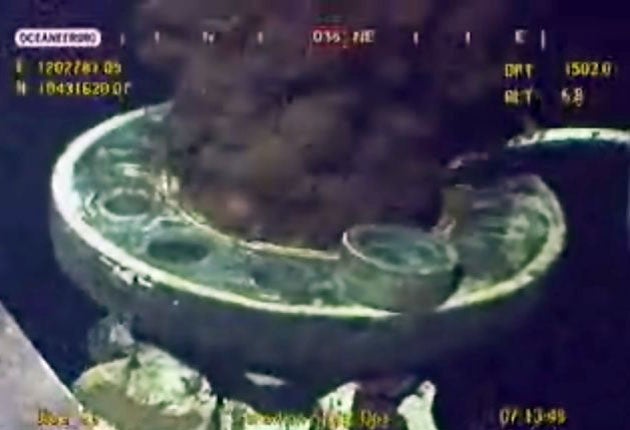BP expresses hope that new 'top hat' will stem spewing oil

The latest high-stakes effort to contain the devastating oil spill in the Gulf of Mexico was making progress last night, BP claimed, as remote-controlled robots continued the painstaking work of affixing a new "top hat" on the gushing well, a mile under the surface of the sea.
It could, however, be another six days before it is clear whether BP's latest efforts to capture the majority of the leaking oil has been successful. By mid-afternoon, the new cap had been lowered into place, stauncing the flow of oil which had beenspewing unchecked, after the company removed an earlier cap that had been funnelling some, but not all, of the oil to the surface. Kent Wells, a BP senior vice-president, said yesterday morning that he was pleased with the progress to date but that the company still feared "something unexpected" could derail the effort.
"It's not like putting a cap on a tube of toothpaste," James McPherson, a US Coast Guard spokesman, added . "It's not just going to be, you put the cap on, it's done."
The stakes could not be higher for BP, which is set to foot the bill for the clean-up operation in the Gulf, which has been mounting as oil and gas continues to gush into the ocean. The company was yesterday the subject of more speculation over its future, amid newspaper reports that its US rival ExxonMobil has been examining a bid for the UK-based company, whose share value has halved since the spill began in April.
BP has already set up a $20bn (£13bn) fund, to be administered by a US government appointee, to distribute compensation to fishermen in the Gulf of Mexico and others whose livelihoods have been wrecked by the disaster.
The latest effort to cap the well follows a string of other attempts. Early in June, BP succeeded in attaching a loose-fitting "top hat" over the broken pipe which has funnelled 15,000 barrels a day to a ship on the surface. That cap was removed on Saturday, and a new, tighter cap is being manoeuvred into place. The new system, which includes more sophisticated options for measuring and potentially regulating the flow of oil, will take three to six more days to attach fully, after which it ought to be able to send the vast majority of the 60,000 barrels leaking every day to waiting ships.
BP says it has brought in a new processing ship and, to deal with the large amounts of oil released during the shift from one cap to another, has also paid for additional skimming vessels to scoop up oil that reaches the surface. The company is also working on two relief wells that should be in place by mid-August, allowing the company to close the well once and for all.
With each passing day, the costs of the disaster are mounting for BP, and the lawyer in charge of the $20bn compensation fund yesterday said he would step up payments to people and businesses affected. Kenneth Feinberg told CNN that his independent claims system would take over from the BP-run system by the first week of August. "We are already prepared to give eligible claimants not one month of emergency payments, but six months with no obligation, no release required, just to try and help people in the Gulf," he said.
There were reports yesterday that BP is already in talks to sell some of its US assets to a Texas-based company called Apache. BP scrapped its dividend and began to consider asset sales as the costs of the Gulf of Mexico disaster mounted last month.
Subscribe to Independent Premium to bookmark this article
Want to bookmark your favourite articles and stories to read or reference later? Start your Independent Premium subscription today.

Join our commenting forum
Join thought-provoking conversations, follow other Independent readers and see their replies